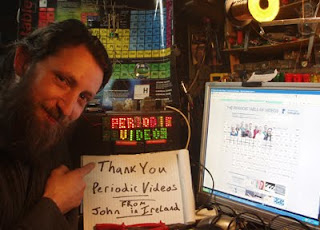Are they worth dabbling with?
Next big thing or flash in the pan?


 It was Google's logo, specially adapted for the occasion, that alerted us.
It was Google's logo, specially adapted for the occasion, that alerted us. The latest addition to Backstage Science is a video about electron guns.
The latest addition to Backstage Science is a video about electron guns. Basically it sees in infrared. And it has 24 little arms which move around the field of vision and focus in on specific galaxies, taking detailed spectra of each of them.
Basically it sees in infrared. And it has 24 little arms which move around the field of vision and focus in on specific galaxies, taking detailed spectra of each of them. Laurence's original blog entry at
Laurence's original blog entry at  Not only does it delve into some cool space stuff and physics - but it deals with humans, jokes and the academic process.
Not only does it delve into some cool space stuff and physics - but it deals with humans, jokes and the academic process. He informs us that he is using Professor Poliakoff as his new university folder icon... And sent photographic proof.
He informs us that he is using Professor Poliakoff as his new university folder icon... And sent photographic proof. It comes from a viewer named Matt (pictured right), but I don't know if it the same Matt who sent us the rock pictures earlier today!?
It comes from a viewer named Matt (pictured right), but I don't know if it the same Matt who sent us the rock pictures earlier today!? You can send me pictures at periodicvideos@gmail.com
You can send me pictures at periodicvideos@gmail.com Earlier today I blogged about a mysterious rock discovered by one of our Canadian viewers.
Earlier today I blogged about a mysterious rock discovered by one of our Canadian viewers.

 One of our viewers has sent us some pictures of a substance, asking for help identifying it.
One of our viewers has sent us some pictures of a substance, asking for help identifying it.








 A monk doing science years before his time, he studied the likes of bees and pea plants.
A monk doing science years before his time, he studied the likes of bees and pea plants.

 This video's a great example of what I hope to achieve with science films.
This video's a great example of what I hope to achieve with science films. And it also contains some discussion about what really happens next as papers are published.
And it also contains some discussion about what really happens next as papers are published. That super intense laser is fired at a tiny target (and I mean tiny), which is unsurprisingly destroyed.
That super intense laser is fired at a tiny target (and I mean tiny), which is unsurprisingly destroyed.

 If chemistry has an "anthem" it must be The Elements by Tom Lehrer.
If chemistry has an "anthem" it must be The Elements by Tom Lehrer. A couple of weeks ago I blogged two videos about solar science.
A couple of weeks ago I blogged two videos about solar science.